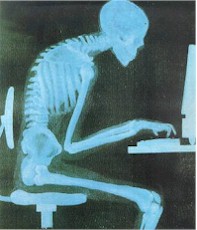 Checking out other massage practices is something I enjoy, especially when traveling. It gives me new ideas and it's just cool to see how other massage therapists conduct themselves. This summer I went to Central America and had massages in both Honduras and Guatemala. In Honduras, I stayed at La Casa de Cafe, a B&B in Copan, where two of the staff provided massage for the guests in an outdoor ramada right next to my room. It had a roof with open walls on three sides and billowing white curtains that offered privacy yet allowed the breeze in. The massage ramada was equipped with a sink, lighting, a few shelves for storage and over looked a dewy pasture where cows quietly grazed.
Checking out other massage practices is something I enjoy, especially when traveling. It gives me new ideas and it's just cool to see how other massage therapists conduct themselves. This summer I went to Central America and had massages in both Honduras and Guatemala. In Honduras, I stayed at La Casa de Cafe, a B&B in Copan, where two of the staff provided massage for the guests in an outdoor ramada right next to my room. It had a roof with open walls on three sides and billowing white curtains that offered privacy yet allowed the breeze in. The massage ramada was equipped with a sink, lighting, a few shelves for storage and over looked a dewy pasture where cows quietly grazed. The therapist that worked on me was a local with one year of experience. She'd graduated from a 500 hour program in Sao Paula, which is the nearest city and about an hour away. She listened and honored my request for gradual pressure with no forceful adjustments. Her boss asked me for an honest critique after the massage as she was going through a trial period and he was concerned her pressure wasn't as deep as his current therapist. My reply to him was that was a good thing as his guests more than likely would have various preferences for pressure. A more valued quality in a therapist is their ability to listen to the client and vary the massage according to those needs, which this gal accomplished (even with my limited Spanish and her limited English).
 In Antigua, Guatemala, I visited the Prana Holistic Center. They had several massage therapists on staff, as well as a psychologist, chiropractor, and a few other health care practitioners. Prana had a couple lovely massage therapy rooms and a large yoga area that faced a lush, green, courtyard. They offered a variety of modalities as well as several different yoga classes. They were having a baby class when I arrived, promoted as a bonding time with parents. The owner had two little ones herself and still took the time to show me around and answer my questions, all the while with her youngest slung across her hip.
In Antigua, Guatemala, I visited the Prana Holistic Center. They had several massage therapists on staff, as well as a psychologist, chiropractor, and a few other health care practitioners. Prana had a couple lovely massage therapy rooms and a large yoga area that faced a lush, green, courtyard. They offered a variety of modalities as well as several different yoga classes. They were having a baby class when I arrived, promoted as a bonding time with parents. The owner had two little ones herself and still took the time to show me around and answer my questions, all the while with her youngest slung across her hip.Another massage therapist, who had worked in different massage centers around the world, visited with me too. She'd been trained in Canada and both she and the owner had graduated from 1200 hour programs. They'd been working as massage therapists for several years and had a more holistic approach with clients.
Although both massage locales were different in their presentation (spa vs. holistic) they tailored their sessions to the person on the table and provided a tranquil, relaxing environment. I hope to go back someday and if you get the chance to visit, don't hesitate.





